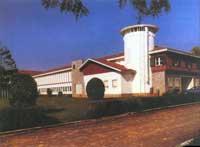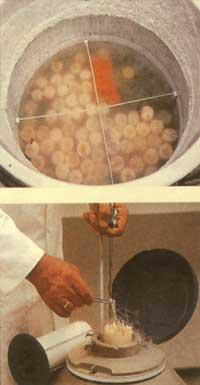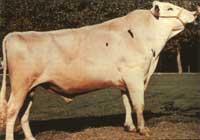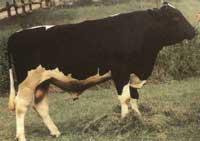Genetic improvement of milk cows in the Basque Country
Steps to test a bull

The baserritarras, to achieve the improvement of the race and to be able to join forces, are grouped in associations. The associations of the Autonomous Community are the following: Gipuzkoa Frisona Association (GI. F.E. ), Frisian Association of Bizkaia (BI.F.E.) and the Asociación de Ganaderos de Frisón Alavés (Asgafal). The functions of these associations include the following. Dairy control, control of genealogical books, selection of seeds, purchase of drugs for campaign and anti-parasitic, etc...
However, these associations were not sufficient to carry out an adequate improvement of the animals. That is why a few years ago (1985), together with the Basque Government and the Provincial Councils, created an anonymous association to channel this task. The name of the association is ABEREKIN S.A.
With animals
When ABEREKIN was born in 1985, the Basque Government and the three Provincial Councils had the majority of the capital, but today the part of the Basque Government has been bought entirely by the Baserritarras and now the majority of the capital is from Frisoi-Societies. The biggest of ABEREKIN are the baserritarras.
The aim of ABEREKIN is to control and correct the genetic improvement of milk cows, in order to achieve greater and better production.
If you want to achieve the goals mentioned, you cannot do the work indifferently. What is intended is to organize proper scientific planning, otherwise we risk getting wrong results. For this it is necessary to design a genetic planning before starting to work. In ABEREKIN, the existing programs on genetic planning were analyzed and the BLUP (Best Linear Unbiased Prediction) was considered the most suitable for its application to Basque reality. What is the BLUP program? That's what we'll discuss next.
Blup methodology

The BLUP methodology used in the advanced countries of the world has four characteristics:
- BEST: It is the minimum variance of the difference between the actual genetic value “u” (unknown to us) and the values of the “-u” solution we obtain. That is, (u-u) 2 is minimal. That's why it's the best.
- LINEAR: The relationship between all selected effects will be linear. For example, the effect between age and production will be linear.
- UNBIASED: All solutions obtained will be close to real value. That is, this methodology will not be wrong.
- PREDICTION: The solution adopted will be prediction or prediction.
BLUP is a statistical technique. And the result obtained resolves all variables that influence production.
There are many variables that can influence the improvement of race and production. However, all of them can be classified into three major groups: environmental, genetic and others.
Environmental variables, size of livestock cattle, month and day of cow breeding, age of livestock, number of breeding, etc. are. These variables are normally fixed in each case and cannot be modified as desired.
Genetic variables, on the other hand, are inevitable and will depend largely on the bull (father).
The other variables can include as many as you want and can be considered a bottomless sack. However, some can be cited such as milk production, fat and protein content and animal size.
These three variables can be related in many ways. It would be best for everyone to relate to everyone, but not so.
One thing is theory, and another (very different) our reality, and to somehow materialize this methodology, ABEREKIN has elaborated a planning that we will explain below.
Selection planning in Euskal Herria

The most important characteristics to take into account in the planning of the selection for the improvement of the production and the breed of beef of the Basque Country according to the BLUP methodology will be classified into four groups:
- Productive characteristics (milk quality, quantity and relationships)
- Unproductive characteristics but with economic implications (weakness of the udder, ease of descending, difficulty giving birth, fertility...)
- Apparent characteristics (body, size, body balance...)
- Characteristics related to meat production.
Once these variables are set, the next step will be to evaluate the animals (livestock) based on them. The genetic level of bulls, cows, calves, urrix, cattle will be assessed.
In genetic improvement an adequate choice of bulls is essential, since they are the ones that provide the most genetic strength to their daughters. Therefore, the good valuation of bulls is mandatory.
Rating of the cattle
The objective of the assessment of bulls is to decide whether or not the bull serves for genetic improvement. It is a proven bull.
To test the beef you have to follow a very strict methodology (see box of the broom) and compare the results obtained later with those of other cattle. After a hard selection, at most two bulls and sometimes only one is taken as an improver. From there this bull will be used to inseminate all the cows.
In order for a bull to be tested and improved, his daughters must get better characteristics than the daughters of other bulls.

The data obtained in the control cannot be used for comparison. Other factors to consider are: The most important and their influence are shown below: the beef group '30%; the year 2%; the beef, the year, the season: 13%; age: 5%; breeding season: 3%; age and breeding season: 2%; Genotype: 11%; breeding period, fertilization interval: 5%; Random: 29%.
In view of this, these factors must be corrected when performing the taurine assessment. If not, because the daughters of one bull (even if it is not as good as another) are in the hands of a good group of cows or good barns, or because they gave birth in spring... they can have better productions than the daughters of a bull better than him, and we would get a wrong assessment.
To take all these features into account, programs include a number of corrective factors.
If the valuation of a bull has not been good, the seed is pulled and the bull dies.
The bull overcome by the test, if it still lives, will continue in the center until other bulls overcome their tests.
All bulls currently in ABEREKIN come from Canada. Some have been tested and others are waiting to know their results.
In the short term, cattle from Euskal Herria cows are expected to be also experienced and improved. In this way, we will be able to escape the dependence of external commercial supplies and interests and, in addition, we will be able to obtain a type of cattle suitable to our environment.
- From the seed of a young bull 600 doses have been extended to different hamlets.
- We know statistically that 60% of productivity has been achieved.
- an average of 360 cows will fertilize with the seed of this young bull.
- 180 ochomiles (50%)
- There are 90 calves left when putting the seed. (Another 50% losses, fatal, from illness, sold abroad, etc.)
- 60% fertility in fertilization.
- There are 54 females, daughters of this bull.
- Meanwhile 15% is lost, when making the baby, finished or because it has no useful lactation.
- There are 40 daughters with a useful and finished milk life.
The first time the seed is removed from the young bull and its daughters end the milk age, almost four years pass. This season, in addition to the first 600 doses, thousands of doses have been removed and stored frozen in liquid nitrogen.
Buletina
Bidali zure helbide elektronikoa eta jaso asteroko buletina zure sarrera-ontzian











